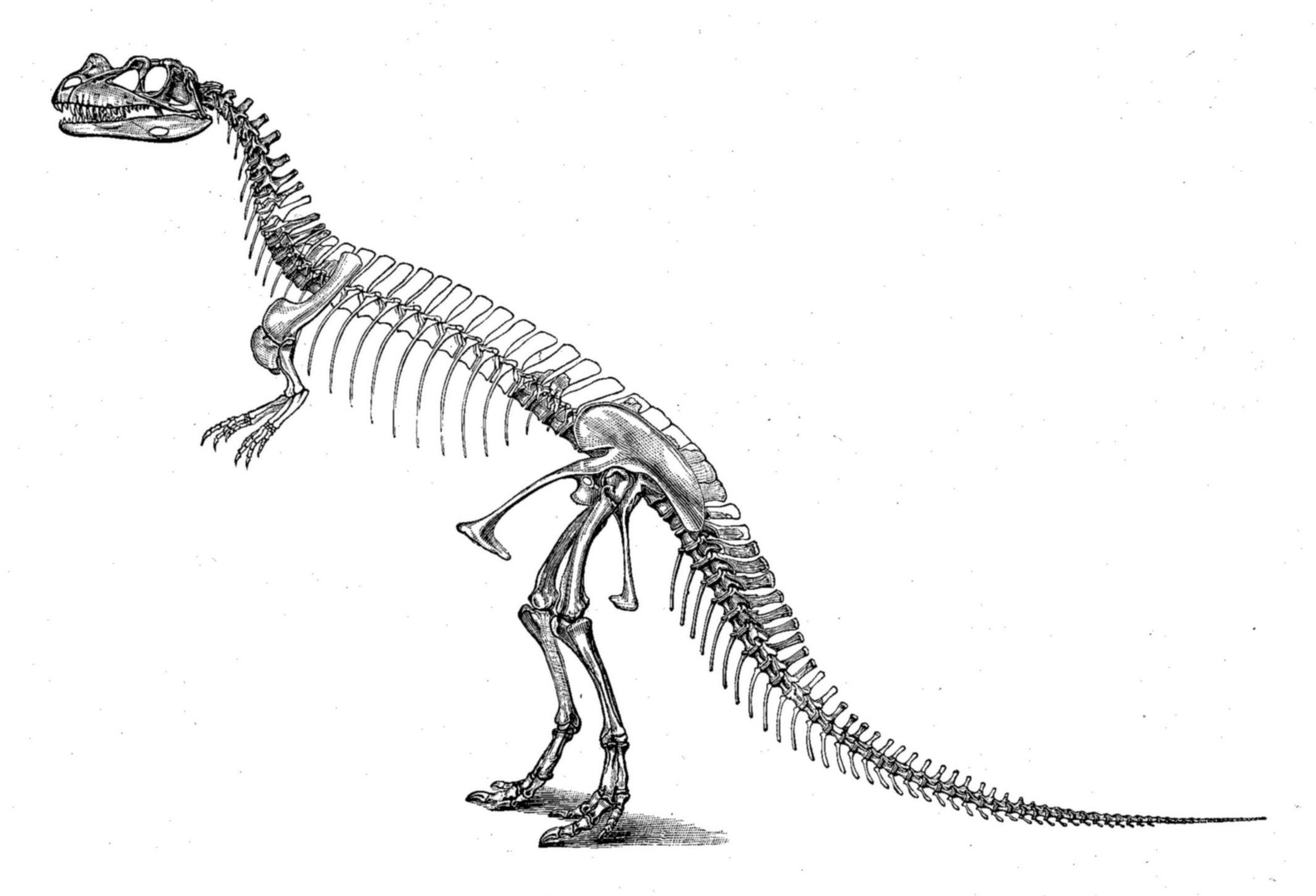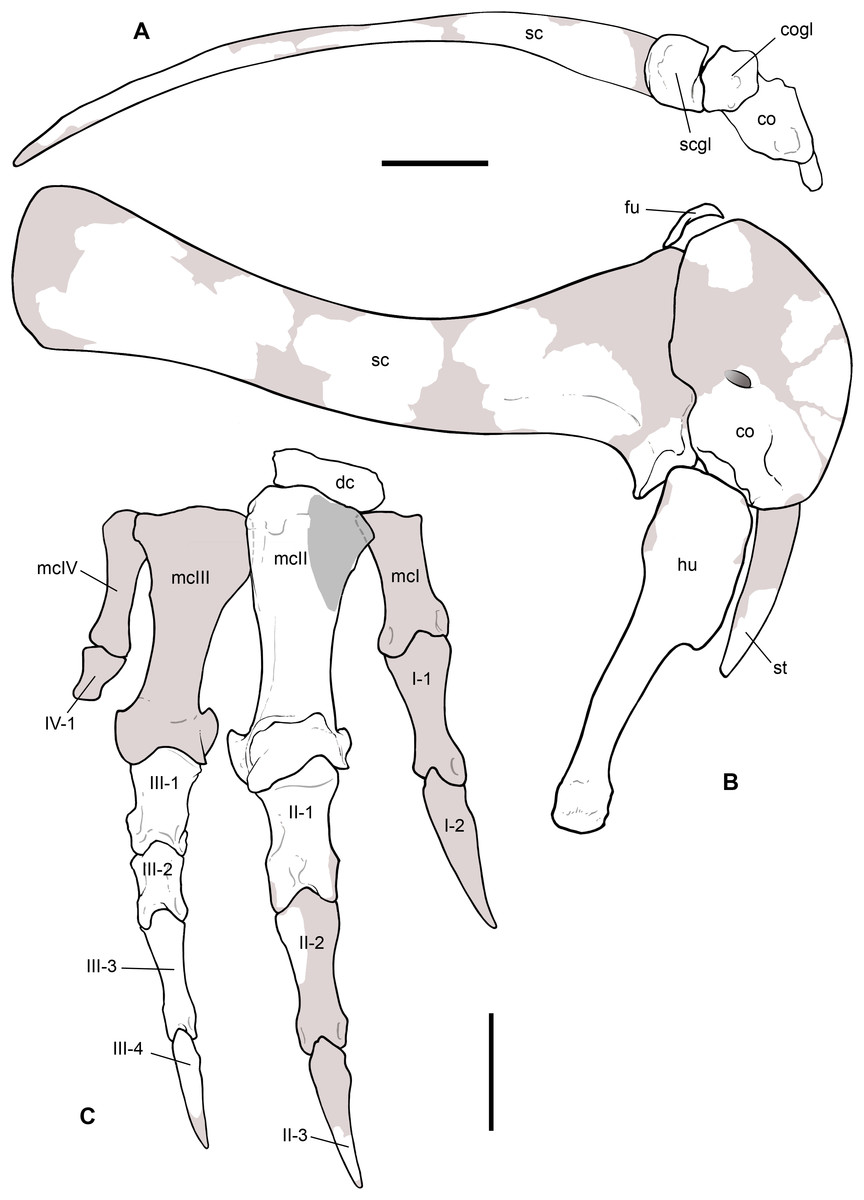|
Ceratosaurid
Ceratosaurs are members of the clade Ceratosauria, a group of dinosaurs defined as all theropods sharing a more recent common ancestor with ''Ceratosaurus'' than with birds. The oldest known ceratosaur, ''Saltriovenator'', dates to the earliest part of the Jurassic, around 199 million years ago. Ceratosauria includes three major clades: Ceratosauridae, Noasauridae, and Abelisauridae, found primarily (though not exclusively) in the Southern Hemisphere. Originally, Ceratosauria included the above dinosaurs plus the Late Triassic to Early Jurassic Coelophysoidea and Dilophosauridae, implying a much earlier divergence of ceratosaurs from other theropods. However, most recent studies have shown that coelophysoids and dilophosaurids do not form a natural group with other ceratosaurs, and are excluded from this group. Ceratosauria derives its names from the type species, ''Ceratosaurus nasicornis'', described by O.C. Marsh in 1884. A moderately large predator from the Late Jurassic, ... [...More Info...] [...Related Items...] OR: [Wikipedia] [Google] [Baidu] |
Ceratosaurus
''Ceratosaurus'' (from Greek 'horn' and 'lizard') is a genus of carnivorous theropod dinosaur that lived in the Late Jurassic period (Kimmeridgian to Tithonian ages). The genus was first described in 1884 by American paleontologist Othniel Charles Marsh based on a nearly complete skeleton discovered in Garden Park, Colorado, in rocks belonging to the Morrison Formation. The type species is ''Ceratosaurus nasicornis''. The Garden Park specimen remains the most complete skeleton known from the genus and only a handful of additional specimens have been described since. Two additional species, ''Ceratosaurus dentisulcatus'' and ''Ceratosaurus magnicornis'', were described in 2000 from two fragmentary skeletons from the Cleveland-Lloyd Quarry of Utah and from the vicinity of Fruita, Colorado. The validity of these additional species has been questioned, however, and all three skeletons possibly represent different growth stages of the same species. In 1999, the discovery o ... [...More Info...] [...Related Items...] OR: [Wikipedia] [Google] [Baidu] |
Eoabelisaurus
''Eoabelisaurus'' () is a genus of abelisauroid theropod dinosaur from the Lower Jurassic Cañadón Asfalto Formation of the Cañadón Asfalto Basin in Argentina, South America. The generic name combines a Greek ἠώς, (''eos''), "dawn", with the name ''Abelisaurus'', in reference to the fact it represents an early relative of the latter. Only one species is currently recognized, ''E. mefi''; the specific name (zoology), specific name honours the MEF, the Museo Paleontológico "Egidio Feruglio", where discoverer Diego Pol is active. It is characterized by reduced forelimb proportions that show primitive characteristics of the Abelisauridae family. Discovery and naming In 2009, Argentinian paleontologist Diego Pol discovered the skeleton of a theropod near the village of Cerro Cóndor in Chubut Province. The remains were found in the Jugo Loco locality that is placed in a series of fine beds of mudstone, marlstone, and limestone in the Cañadón Asfalto Formation. In 2012, bas ... [...More Info...] [...Related Items...] OR: [Wikipedia] [Google] [Baidu] |
Abelisauridae
Abelisauridae (meaning "Abel's lizards") is a family (or clade) of ceratosaurian theropod dinosaurs. Abelisaurids thrived during the Cretaceous period, on the ancient southern supercontinent of Gondwana, and today their fossil remains are found on the modern continents of Africa and South America, as well as on the Indian subcontinent and the island of Madagascar. Isolated teeth were found in the Late Jurassic of Portugal, and the Late Cretaceous genera '' Tarascosaurus'', '' Arcovenator'' and '' Caletodraco'' have been described in France. Abelisaurids possibly first appeared during the Jurassic period based on fossil records, and some genera survived until the end of the Mesozoic era, around . Like most theropods, abelisaurids were carnivorous bipeds. They were characterized by stocky hind limbs and extensive ornamentation of the skull bones, with grooves and pits. In many abelisaurids, such as ''Carnotaurus'', the forelimbs are vestigial, the skull is shorter, and bony cres ... [...More Info...] [...Related Items...] OR: [Wikipedia] [Google] [Baidu] |
Berthasaura
''Berthasaura'' (meaning "Bertha's lizard") is an extinct genus of ceratosaurian theropod dinosaurs from the Early Cretaceous Goio-Erê Formation of Paraná, Brazil. The genus contains a single species, ''Berthasaura leopoldinae'', known from a nearly complete skeleton. Discovery and naming Between 2011 and 2015, paleontologists working at the Cemitério dos Pterossauros site near Cruzeiro do Oeste discovered the skeletons of the pterosaurs '' Caiuajara'', ''Keresdrakon'' and '' Torukjara'' as well as remains of small theropods. One of these was in 2019 named and described as ''Vespersaurus'' but a second species proved to be present. In 2021, the type species ''Berthasaura leopoldinae'' was named and described by Geovane Alves de Souza, Marina Bento Soares, Luiz Carlos Weinschütz, Everton Wilner, Ricardo Tadeu Lopes, Olga Maria Oliveira de Araújo and Alexander Wilhelm Armin Kellner. The generic name ''Berthasaura'' refers to the scientist and women's rights activist Bert ... [...More Info...] [...Related Items...] OR: [Wikipedia] [Google] [Baidu] |
Ostafrikasaurus
''Ostafrikasaurus'' is a potentially nomen dubium, dubious genus of theropod dinosaur from the Late Jurassic Period (geologic time), period of what is now Lindi Region, Tanzania. It is known only from fossil teeth discovered sometime between 1909 and 1912, during an expedition to the Tendaguru Formation by the Natural History Museum, Berlin, Natural History Museum of Berlin. Eight teeth were originally attributed to the Dubious name, dubious dinosaur genus ''Labrosaurus'', and later to ''Ceratosaurus'', both known from the North American Morrison Formation. Subsequent studies attributed two of these teeth to a Spinosauridae, spinosaurid dinosaur, and in 2012 in paleontology, 2012, ''Ostafrikasaurus crassiserratus'' was named by French palaeontologist Eric Buffetaut, with one tooth as the holotype, and the other referred to the same species. The generic name comes from the German word for German East Africa, the former name of the colony in which the fossils were found, while the sp ... [...More Info...] [...Related Items...] OR: [Wikipedia] [Google] [Baidu] |
Austrocheirus
''Austrocheirus'' is an extinct genus of theropod dinosaur that lived during the Late Cretaceous period. It was named and described by Martin Ezcurra, Federico Agnolin and Fernando Novas in 2010 in paleontology, 2010. It contains the type species ''Austrocheirus isasii''. The generic name means "southern hand". The specific name (zoology), specific epithet honours discoverer and preparator Marcelo Pablo Isasi. The fossils were found on 17 March 2002 in the Pari Aike Formation, dating from the Campanian to Maastrichtian. These fossils consist of a partial manus (anatomy), manus (hand), a tibia, Axial skeleton, axial bones, and a foot bone. ''Austrocheirus'' was a medium-sized theropod measuring long. Classification A cladistic analysis indicated ''Austrocheirus'' had a basal position in the Abelisauroidea, but was more derived than ''Ceratosaurus'' and ''Berberosaurus''. This would make it the first known mid-sized abelisauroid which did not possess the reduced forelimbs seen i ... [...More Info...] [...Related Items...] OR: [Wikipedia] [Google] [Baidu] |
Afromimus
''Afromimus'' (meaning "Africa mimic") is a genus of ceratosaurian theropod dinosaur from the Early Cretaceous Elrhaz Formation of Niger. It contains a single species, ''A. tenerensis'', named in 2017 by Paul Sereno from parts of the right leg, vertebrae, and ribs found in the Ténéré Desert. It was originally described as a genus of ornithomimosaurian, but subsequent arguments have placed it as a taxon within or close to the superfamily Abelisauroidea. Discovery and naming The only known specimen of ''Afromimus'' is a partial skeleton consisting of seven (originating from the middle of the tail and estimated to be the 15th, 16th, 18th, 20th, 22nd, 24th, and 27th tail vertebrae), bones from the right hindlimb (the , , , and ), and part of a rib, all found within a radius of . It was discovered in 1997 at the Gadoufaoua locality in the Elrhaz Formation, in the Ténéré Desert of Niger. The specimen is catalogued as MNBH GAD112 in the Musée National Boubou Hama, the natio ... [...More Info...] [...Related Items...] OR: [Wikipedia] [Google] [Baidu] |
Spinostropheus
''Spinostropheus'' is a genus of carnivorous neotheropod theropod dinosaur that lived in the Middle Jurassic period and has been found in the Tiouraren Formation, Niger. The type and only species is ''S. gautieri''. History of discovery In 1959, Albert-Félix de Lapparent excavated fossils near Oued Timmersöi, west of In Tedreft in the Agadez desert. Among the finds were the remains of a theropod. In 1960, de Lapparent, based on these, named a second species of the genus ''Elaphrosaurus'', ''E. gautieri''. The specific name honours François Gautier, the discoverer of the type locality. In 2004, Paul Sereno, John Wilson and John Conrad named a separate genus: ''Spinostropheus''. The generic name is derived from Latin ''spina'', "spine", and Greek στροφεύς, ''stropheus'', "vertebra", and refers to the epipophyseal processes of the cervical vertebrae, which are prominent and dorso-ventrally flattened. The holotype, MNHN 1961-28, was found in a layer of the Tiour ... [...More Info...] [...Related Items...] OR: [Wikipedia] [Google] [Baidu] |
Saltriovenator
''Saltriovenator'' (meaning " Saltrio hunter") is a genus of ceratosaurian dinosaur that lived during the Sinemurian stage of the Early Jurassic in what is now Italy. The type and only species is ''Saltriovenator zanellai''; in the past, the species had been known under the informal name "saltriosaur". Although a full skeleton has not yet been discovered, ''Saltriovenator'' is thought to have been a large, bipedal carnivore similar to ''Ceratosaurus''. Discovery and naming On 4 August 1996, the first remains of ''Saltriovenator'' were discovered by amateur paleontologist Angelo Zanella, searching for ammonites in the ''Salnova'' marble quarry in Saltrio, northern Italy. Zanella had already been working for the ''Museo Civico di Storia Naturale di Milano'' and this institution after being informed sent out a team to investigate the find. Cristiano Dal Sasso and the volunteers of the Paleontological Group of Besano, under the direction of Giorgio Teruzzi managed to salvage a num ... [...More Info...] [...Related Items...] OR: [Wikipedia] [Google] [Baidu] |
Berberosaurus
''Berberosaurus'' (meaning "Berber lizard", in reference to the Berbers of Morocco) is a genus of neotheropod dinosaur, possibly a ceratosaur, from the Toarcian-age (Lower Jurassic) "Toundoute Continental Series" (Azilal Formation) found in the Central High Atlas of Toundoute, Ouarzazate, Morocco. The type species of the genus ''Berberosaurus'' is ''B. liassicus'', in reference to the Lias epoch. ''Berberosaurus'' might be the oldest known ceratosaur, and is based on partial postcranial remains. This genus represents the oldest formally identified theropod from the North of Africa, as well one of the few from the region in the Early Jurassic. Discovery and history The remains of ''Berberosaurus'' were discovered during a series of expeditions to the High Atlas beginning in the early 2000s, when in 6 years, where made to dig in the local redbeds. It is based on an associated partial postcranial skeleton of a subadult individual cataloged in the Muséum d'Histoire Naturelle de M ... [...More Info...] [...Related Items...] OR: [Wikipedia] [Google] [Baidu] |
Noasauridae
Noasauridae is an extinct family of theropod dinosaurs belonging to the group Ceratosauria. They were closely related to the short-armed Abelisauridae, abelisaurids, although most noasaurids had much more traditional body types generally similar to other theropods. Their heads, on the other hand, had unusual adaptations depending on the subfamily. 'Traditional' noasaurids, sometimes grouped in the subfamily Noasaurinae, had sharp teeth which splayed outwards from a downturned lower jaw. The most complete and well-known example of these kinds of noasaurids was ''Masiakasaurus knopfleri'' from Madagascar. Another group, Elaphrosaurinae, has also been placed within Noasauridae by some studies. Elaphrosaurines developed toothless jaws and Herbivore, herbivorous diets, at least as adults. The most complete and well known elaphrosaurine was ''Limusaurus, Limusaurus inextricabilis''. At least some noasaurids had Skeletal pneumaticity, pneumatised cervical vertebrae.Arthur Souza Brum, ... [...More Info...] [...Related Items...] OR: [Wikipedia] [Google] [Baidu] |






